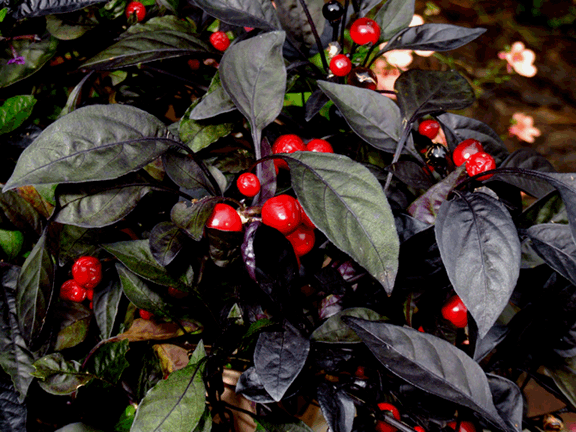![]()
Collection
Take the Tour Now?
Orchids
The
Exotic Rainforest
Plants in
the Exotic Rainforest Collection

Janice and I made a brief visit to the Franklin Park Conservatory in Columbus, Ohio in 2006. The conservatory is one of America's oldest botanical gardens with a very interesting collection of tropical plants. Outside the entrance we noticed a very enticing species with black leaves which appeared to be a pepper. It was, and it had no sign. Before anyone could reach to pick one of the brilliant red fruits an attendant warned not to touch the plant! The plant was hot. Very hot! The South American species has many variations, over 20 with synonym scientific names (same plant, other name.). The variation at Franklin Park is the first to produce black leaves.
The beautiful plant grows to 45 to 50cm (18 to 20 inches) in height with a spread of 40 to 48cm (16 to 19 inches). When the plant first blooms the species produces a lilac flower which then produces a black pepper that matures to red. The fruit is approximately 2cm (3/4 inch) and is a shiny round pepper that has a very hot taste! As a result, the pepper's oil can be hazardous to your skin and eyes! The Franklin Park variation is one of the All America Selection Flower Winners for 2006. This variety is now being sold at some nurseries as an annual but it is actually a perennial. If you can collect a fruit (carefully) it takes approximately 20 to 24 weeks from seed to flower to first fruit.
Barb Arnold, Horticultural Designer of the Franklin Park Conservatory advised me the plant performs wonderfully in a container all summer. However, she points out the peppers were very enticing to children and adults who quickly found the oil was detrimental to their eyes! She said, "I will say this ornamental pepper's capsaicin is one of the worst on your skin and burns horribly". As a result, should you elect to grow this beautiful plant do not allow your children, grand children or pets to touch the fruit. The beauty of the plant can be dangerous to those not informed! The plant is native to much of South America and Mexico. Obviously, we "borrowed" a fruit!